On the loss of tanks Abrams
Main tanks of the M1 Abrams family have been manufactured and operated since the end of the seventies. Over the next several decades, a number of new modifications of the armored vehicle were created, differing from each other in the composition of weapons, electronic equipment, protection, etc. The creation of new systems for these tanks is still ongoing. For three and a half decades of service, the Abrams tanks of the American army and the armed forces of other states managed to take part in several armed conflicts. The debut of this technology took place during the Gulf War in the early nineties. In the two thousandth American tanks returned to Iraq to participate in the new war. In addition, they managed to work in Afghanistan. Currently, M1A1 army of Saudi Arabia are used in battles on the territory of Yemen.
Like any other military equipment, the Abrams family of tanks were not insured against loss. At the beginning of 1991, the tanks were attracted to participate in Operation Desert Storm, and in mid-February suffered the first losses. The second conflict in Iraq, which began in 2003, also ended with the loss of a significant number of tanks. Available information allows us to study the situation with the loss of the M1 family of tanks and to draw certain conclusions.
"Desert Storm"
Initially, information about the losses of American armored vehicles in the war with Iraq was not published. Only some time after the end of conflicts, information about the results of the fighting in terms of damage and loss of armored vehicles became public knowledge. According to these data, 21 tank M1A1 Abrams were damaged or lost during the battles, and several tank crews were wounded. In addition, one member of the crew of the armored vehicle died in battle.
The first incident involving Abrams was the blasting of a B-31 tank from the TF 1-5 subunit, which occurred on February 19 of the year 1991, on a mine. The explosion damaged the chassis and power plant. February 24 on mine exploded another tank, but light damage allowed to quickly return it to service. In the course of these two cases, the crews were not injured and continued service.
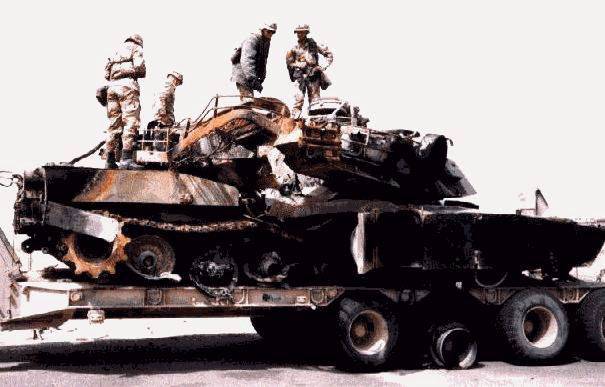
TF 23-1 Tank B-37, attacked by AH-64 helicopter, February 1991. Photo by Wikimedia Commons
On the night of February 26, the TF 1-37 1 Armored Division, attacking the Tavacalna division, mistakenly became the target of AH-64 Apache helicopters, which caused serious damage to equipment and injuries to crews. The B-23, C-12, C-66 and D-24 vehicles became the target of Hellfire missiles and were damaged. In addition, one tanker from the B-23 crew, two from D-24 and three from C-66 were injured. According to some reports, the C-12 was also subjected to shelling by armor-piercing shells on its part, and the B-23 became the target of Iraqi tank crews, as a result of which it caught fire. Subsequently, the B-23 tank was decommissioned due to the impossibility of recovery, and the remaining three cars went for repairs.
Also, during the battles with the Tavakalna division, three tanks of the TF 4-8 3 armored division were damaged. During the enemy shelling, some external aggregates of the B-24 and C-12 tanks were damaged. In the case of the latter, one tankman was wounded. In addition, the C-24 was the victim of "friendly fire", which resulted in damage to external units and equipment.
On the same day, five tanks of the TF 1-41 2 Armored Division, which participated in the battles on the Norfolk Line, were damaged. At the same time, the B-22 machine came under fire from armored-piercing shells based on depleted uranium, but did not receive any internal damage, although one tanker was wounded. A-31 and A-33 received various shell damage from TOW missiles or armor-piercing shells. Three A-33 tank crews were injured. The A-14 tank was hit by a “uranium” projectile and caught fire, causing three crew members to suffer. Also 26 February was the only death of the tanker. The B-66 was hit by a grenade launcher, after which it received three hits of armor-piercing shells. As a result, the ammunition detonated. Three tankers were saved, but received various injuries.
February 27 The 197 I brigade of the 24 Infantry Division lost three tanks that had participated in the attack on the airfield Talil. One of them was immobilized by enemy fire, the other two were stuck in the mud. The armored vehicles abandoned by the crews were shot by the Allies and did not become enemy trophies. On the same day, the commander tank HQ-66 of the TF 4-64 division of the same division in the area of Basra was attacked by an 100-mm anti-tank gun. No one was hurt, but minor repairs and replacement of the gunner's sight were needed. The very next day, the tank returned to service. March X-NUMX A-2 tank of the TF 22-4 was fired on the Iraqi T-64 and caught fire with the subsequent detonation of ammunition. One tanker was injured.
During the fighting in Iraq, two dozen American tanks received various damage, and several were destroyed. A characteristic feature of those events is a large number of minor damages that were repaired in a matter of hours or days. In addition, there is no information about the destruction of "Abrams" by Iraqi tanks during the fighting, which may be associated with the use of obsolete tank ammunition.
The relatively small losses of US Army tanks may have several explanations. First of all, this is the short duration of the battles: an active ground operation with the use of tanks lasted only a few weeks. In addition, the weakening of the Iraqi army due to massive aviation blows. Also an important factor was the superiority of the American armed forces in the field of intelligence, command and communications. Finally, we should not forget the uniquely large number of erroneous strikes against friendly or allied forces, which also affected M1A1 tanks and significantly reduced the proportion of losses or damage from enemy fire.
"Iraqi Freedom"
In March, 2003, an international coalition led by the United States again invaded Iraq, this time to overthrow Saddam Hussein. The military operation, during which the coalition fought with the Iraqi army, ended in the late spring of the same year, but subsequently NATO forces had to fight for several years against partisan and terrorist movements, as well as to try to establish a peaceful life.
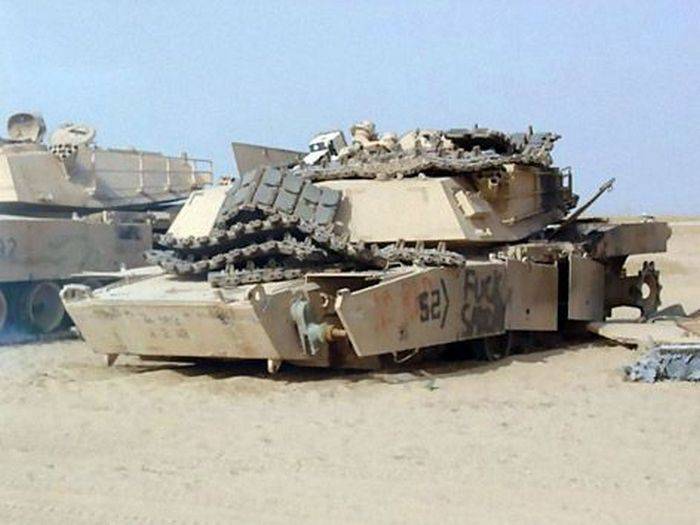
Tank, hit by 3 on April 2003 after the evacuation. Photo Forum.guns.ru
In Operation Iraqi Freedom and subsequent events, Abrams tanks played a major role. They actively participated in various clashes with the enemy and were one of the main shock forces of the coalition. Naturally, not without damage and losses. At the same time, however, official data on this subject has not yet been published. Only in February 2005 of the year, the head of the Pentagon’s Armored Directorate General Terry Tucker said that 80 tanks had been returned to the United States by that time for repairs. 63 machines are subject to repair, and the rest, probably, will not return to the system. Other details were not disclosed. For this reason, specialists and the interested public had to independently search for data and process scattered information.
The first damage to the tank M1A1 Abrams in the course of the new war occurred at the very beginning of it - on the night of March 21 2003. A platoon of 1 tanks of the battalion of the 1 division of the ILC carried out the protection of Kuwaiti troops on the border with Iraq. In addition, AH-1W attack helicopters patrolled the area. The pilot of one of the helicopters lost orientation and took one of the Abrams for the approaching Iraqi tank. A Hellfire rocket with a high-explosive fragmentation warhead was launched. The rocket damaged the onboard screen and the chassis of the armored vehicle. The board was not pierced, but one of the tankers was injured. According to some information, the damaged tank was not repaired later, but was used as a source of spare parts.
March 25, an American column of armored vehicles from the 7 Cavalry Regiment of the 3 Infantry Division in the area of An-Najaf marched through a sandstorm and was ambushed. Two anti-tank grenades hit the turret of the B-24, but the vehicle did not receive any significant damage. Shortly thereafter, the tank was accidentally subjected to fire by the M2 Bradley infantry fighting vehicle, as a result of which the hull and tower feeds were pierced. In the laying of ammunition started a fire, because of what the crew had to leave the car. Tank B-23 followed and was also shot down (exact circumstances unknown). Eight tankers successfully evacuated and BMPs were selected. Burnt tanks remained on the battlefield and were used by Iraq for propaganda purposes. Soon the Americans evacuated them.
March 25 tank with the call of Hermes from the company of the C 1-th tank battalion of the 1-th division of the ILC at the crossing of the river. Euphrates fell from the bridge and lay on the bottom of the tower down. For the first time in the years of operation of the M1A1 tanks, the entire crew was killed. A few days later the armored car was pulled out.
3 April The 2 Brigade of the 3 Infantry Division lost the tank with the B-52 number. During the attack on the Saints object, this vehicle moved ahead and fought against the enemy’s infantry. The crew spent the entire ammunition coaxial machine gun, which is why the commander had to fire from anti-aircraft. Continuing the battle, the commander was twice wounded in the arm. Soon, the enemy’s fire damaged the stern of the tower, where the auxiliary installation was located. The latter caught fire, but the crew continued to move and did not leave the battlefield. The fire of the Armed Forces of Ukraine led to the spill of fuel and the ignition of the main engine. Only after that the crew left the car, which was later sent for repairs. In addition to the commander, no one was hurt.
The next day, two tanks of the 2 th battalion of the 1 division of the ILC were hit. The battalion was moving on the highway number XXUMX in the direction of Baghdad, but due to an error of command, it turned off at the wrong turn and was ambushed. The tank of the company commander C with the call sign Let's Roll was immobilized during the battle, after which an enemy anti-tank grenade was damaged by an external fuel tank. Fuel spilled, ignited and got into the engine. Similar damage was received by another battalion tank.
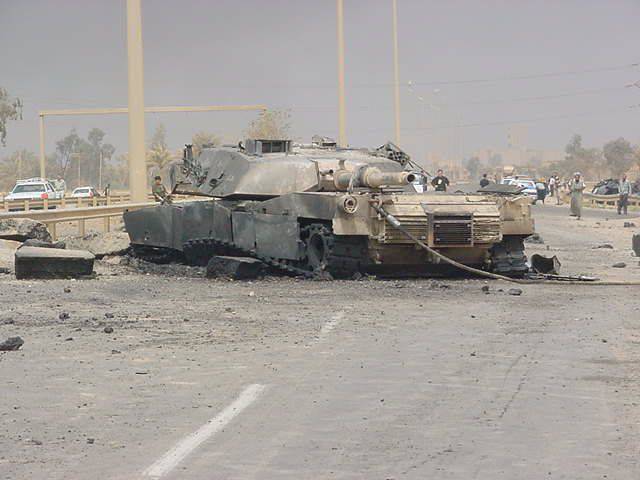
Tank Cojone Eh, damaged and inflamed 5 April 2003. Photo by Forum.guns.ru
On April 5, the Cojone Eh tank from the 64 9th Tank Regiment of the 3 Infantry Division was lost. Participating in battles in the suburbs of Baghdad, the tank received damage from enemy artillery. After the projectile hit, the fuel from the onboard tank caught fire, soon the fire spread to the engine. The crew and other tankers attempted to put out the fire, but could not do it for 20 minutes. The battalion commander ordered to take everything from the tank and throw it, continuing the offensive. After removing all the necessary things, a couple of grenades were thrown into the fighting compartment, and the stern of the tower was fired from another tank. The ammunition burned out and knocked out the roof panels. Shortly thereafter, the wrecked tank tried to use Iraqi propaganda, to counter which it was fired at by missiles. In the future, the car dragged to the side. The subsequent fate of Cojone Eh is unknown. This tank was the last "Abrams", lost during battles with Iraqi troops.
Guerrilla war in Iraq
1 May 2003, the American leadership announced the end of hostilities in Iraq. The army coped with the tasks, destroyed the enemy's armed forces and now moves to patrolling the occupied territories and other works. However, the end of the fighting did not allow to completely get rid of losses. The war actually turned into a partisan form, because of which the NATO coalition continued to suffer losses in manpower and equipment. Guerrilla and terrorist groups began to regularly attempt to attack columns, bases, etc., belonging to coalition forces, including the United States. During these actions, among other things, Abrams tanks of all combat modifications suffered.
28 August 2003, a company of the B 2 Battalion, 70 Tank Regiment, 1 Tank Division, conducted patrols in Baghdad. One of the tanks was fired from hand grenade launchers. The grenade hit the starboard, broke through the screen and damaged the turret chase. One tanker was slightly injured.
On October 28, the tank M1A2 SEP of the 67-th tank regiment of the 4-th Infantry Division in the area of Baakuba was blown up on an improvised explosive device. The driver and commander died, the gunner was seriously wounded, but survived. Charging in the car was missing. According to the gunner, the VCA consisted of two 155-mm shells and 160 kg of explosives. A powerful explosion severely damaged the body and chassis, as well as the tower. The tank was not restored.
The events in Fallujah led to new battles and new casualties. 7 on April 2004 of the Abrams Company of the C 1 Tank Battalion of the 1 Division of the ILC led the offensive and advanced to its infantry. Taking advantage of this, the enemy's grenade launcher fired a shot and inflicted minor damage to the turret. The tank commander decided to respond to the enemy with anti-aircraft machine gun fire. At the same time there was a second shot from a grenade launcher. The grenade hit the manhole cover, which is why the commander was seriously wounded, and the gunner and loader received minor injuries. Despite damage to the hatch, the tank soon returned to service.
On April 10 in Baghdad and on August 16 in Sadr City, two tanks were hit with grenade launchers. No one died, but the crews were injured. November 22 in Baghdad on IEDs blew a transporter-tank carrier with the Abrams on a semi-trailer. Both cars were burned, two servicemen were injured.
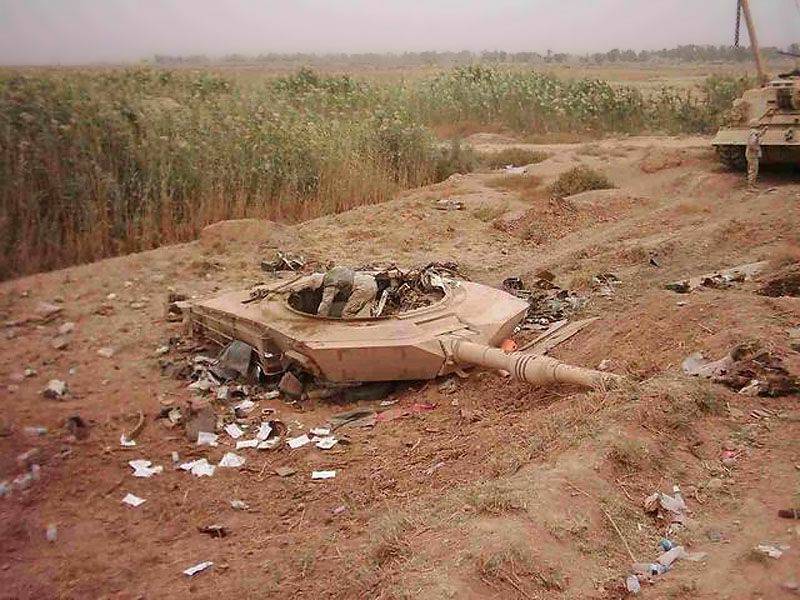
Torn tower of a blown up tank. Photo Forum.guns.ru
The 30 of August, 16 of September, 11 of November and 25 of December in various parts of Iraq on improvised explosive devices blew up five American tanks. For example, in August and September, the armored vehicles were completely destroyed, and on September 16 two tankers were killed and two were injured (a tower flew from the tank when it blew up). Also in September, another tank was damaged, which went to the aid of the wounded and also hit the IED. In this case, one person was killed, one was wounded, and the tank was subsequently restored. In the November incident, one tanker was killed, two were injured. The tank was not recoverable. The same results were at the December bombing.
According to reports, in 2006, there were several more attacks, during which the tanks fell on explosive devices. They occurred on March 10 (the tank caught fire, the crew was not injured), April 9 (crew alive, tank lost), July 15 (injured 3, the tank could not be restored) died), August 18 (tank burned during evacuation), August 3 (tank burned), September 15 (tank burned, 18 military personnel suffered), December 5 (tank lost, 8 wounded) and December 1 (allegedly lost lost).
Also in 2006, there was one case of the defeat of the tank M1A2 SEP Abrams from a grenade launcher (October 9), as a result of which the car burned down, but the crew escaped. 11 May was the second case of the death of the tank, along with the entire crew. During the crossing of the river near the city of Karma, the tank of the 2 tank battalion of the 2 division of the ILC fell into the water.
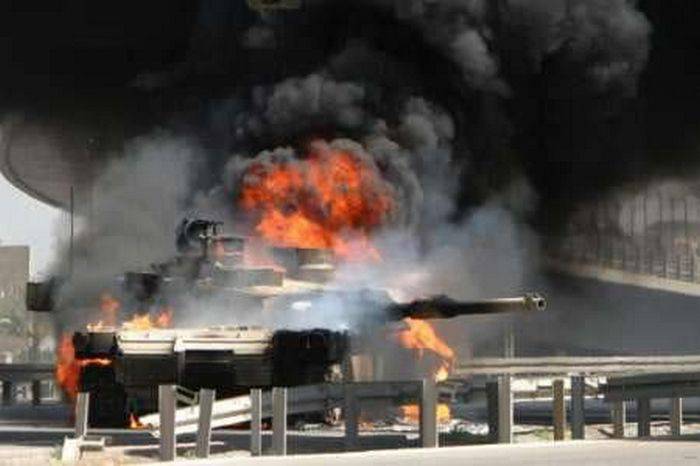
Tank M1A2, padded on the road to Baghdad airport, 10 in April 2004. Photo by Forum.guns.ru
During the first half of 2007, six bombings of the Abrams tanks on improvised explosive devices occurred, most of which led to the loss of equipment. In addition, several tankers were injured. 17 February of the same year in Fallujah a convoy of vehicles was ambushed, as a result of which the tank M1A1 caught fire and four crew members were injured.
The latest cases of the loss of US tanks in Iraq refer to 2008. January 30 and April 8 on IED blew two tanks. Several people were injured, equipment burned out and could not be recovered.
It is easy to see that in the course of direct hostilities in the spring of 2003, American troops lost a minimum number of tanks. During the fighting, Iraqi troops could not cause significant damage to the enemy, which predetermined the outcome of the war. It can be assumed that the reasons for this were the same as in the case of the 1991 battles of the year. Affected by superiority in technology, intelligence, communications, control, etc. As a result, during the battles, including the battle for Fallujah, less than a dozen tanks were put out of action, some of which were soon repaired and returned to service.
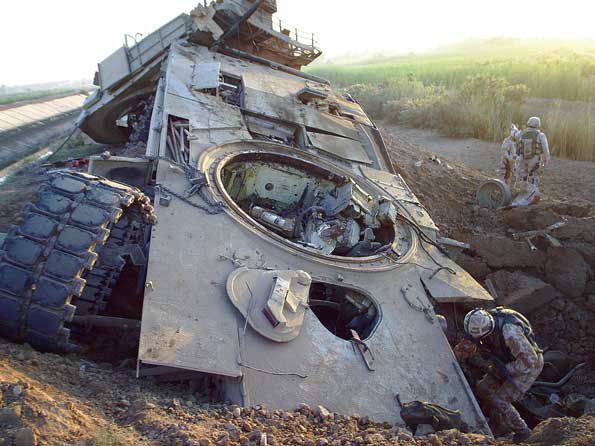
The remains of a tank that exploded on SVU 16 September 2005. Photo by Forum.guns.ru
Where the American armored units suffered heavy losses after the completion of the main battles, when the enemy turned to guerrilla tactics. As a result of the use of IEDs and ambushes, Iraqi armed forces managed to inflict heavy losses on the enemy. In addition, it should be noted that the use of explosive devices significantly reduced the likelihood of the return of tanks to service after repair.
Conflicts of the past years
The Middle East is still restless, and the Abrams are not without work. After the victory over S. Hussein, the United States began to form a new Iraqi army, which received a large number of American-made military equipment, including Abrams family tanks. In 2014, this technique again took part in the battles, but could no longer boast of effectiveness.
After the emergence of the terrorist organization Islamic State of Iraq and the Levant (banned in Russia), Iraqi forces tried to resist it, but failed to hold offensive. As a result, the terrorists got a large number of vehicles, including American-made tanks. Some tanks were indicatively undermined or fired using various types of anti-tank systems, after which videotapes of such “operations” were used by terrorists for propaganda purposes. For obvious reasons, such incidents cannot be viewed in the context of combat effectiveness and combat losses. Nevertheless, the published frames are of particular interest from the point of view of studying the processes occurring during the defeat of armored vehicles with one or other anti-tank weapons.
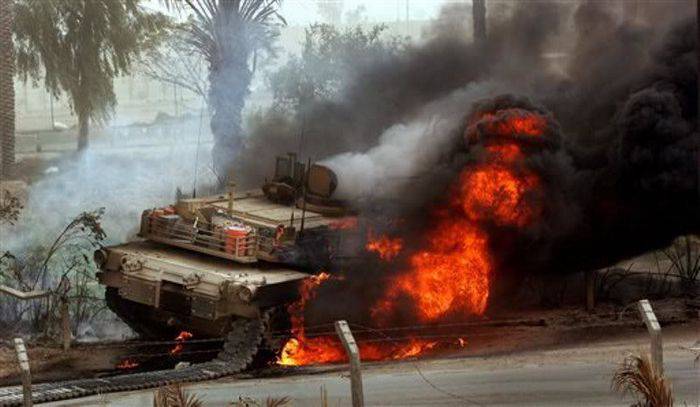
The result of the explosion at the SVU, 10 March 2006. Photo Forum.guns.ru
Currently, a coalition led by Saudi Arabia is fighting in Yemen. Armed with the Arabian army are tanks M1A1 Abrams, which are actively involved in hostilities. Unfortunately, detailed information on the use of this technique and losses, as well as the circumstances of the losses, is not yet available. From time to time the parties to the conflict publish various videos taken during the fighting. For example, 24 in August last year was published a video with the destruction of two Abrams tanks with the help of anti-tank systems. According to some data, while using the system "Fagot" Soviet production. As seen on these records, similar weaponWhen properly used, it can effectively and effectively destroy armored vehicles.
Results
For three and a half decades, several thousand Abrams tanks were built in several modifications. In addition, since the early nineties in the battles have been lost dozens of similar armored vehicles. Quite expectedly, despite all the accolades, the Abrams tanks did not become fundamentally invincible and invulnerable. Like other military equipment, they can also get damaged and die. Therefore, its relevance still retains the question of the causes of the death of technology.
Considering the two wars in Iraq, it can be noted that the greatest successes and the smallest losses of tanks belonged to the period of full-fledged open hostilities. Fighting with the ground forces of the enemy "in the open field", American tanks show good results and cope with the tasks. Due to the support of aviation, intelligence, etc. Tank results are getting even better. That was the case in February 1991 of the year and in the spring of 2003.
However, in the summer of 2003, the situation changed markedly. Tanks had to learn non-standard "professions": they accompanied the convoys, conducted patrols and solved other tasks that were not characteristic of them. In response, the enemy began to organize ambushes and use improvised explosive devices. As a result, the loss of manpower and equipment in “peacetime” quickly caught up with the fighting, and then exceeded them.
In the context of tanks, all these events are evidence of a well-known truth: without special equipment, a tank cannot work effectively in conditions of cities or other populated areas. In urban areas, armored vehicles are becoming an easy target for grenade throwers. In addition, tanks have extremely limited resistance to explosive devices, especially powerful, which further increases the risks in the conditions of modern local conflicts.
To be fair, it should be noted that, based on the results of the fighting, American tank builders took measures and developed a set of additional equipment TUSK, with the help of which it is proposed to increase the survivability of M1A1 / A2 Abrams tanks in urban environments. Such equipment has already been purchased, but has not yet been tested in real conflicts. It is possible that such equipment will reduce the risks for the equipment and its crews, but it will not help to return the lost cars and dead people. Therefore, all interested parties should study and take into account American experience, as well as use it in their new developments and strategies.
On the materials of the sites:
http://globalsecurity.org/
http://defense-update.com/
http://armyrecognition.com/
http://defenseindustrydaily.com/
http://vestnik-rm.ru/
http://artofwar.ru/
A detailed description of tank losses in Iraq in 2003-2008:
http://artofwar.ru/p/ponamarchuk_e/text_0300.shtml
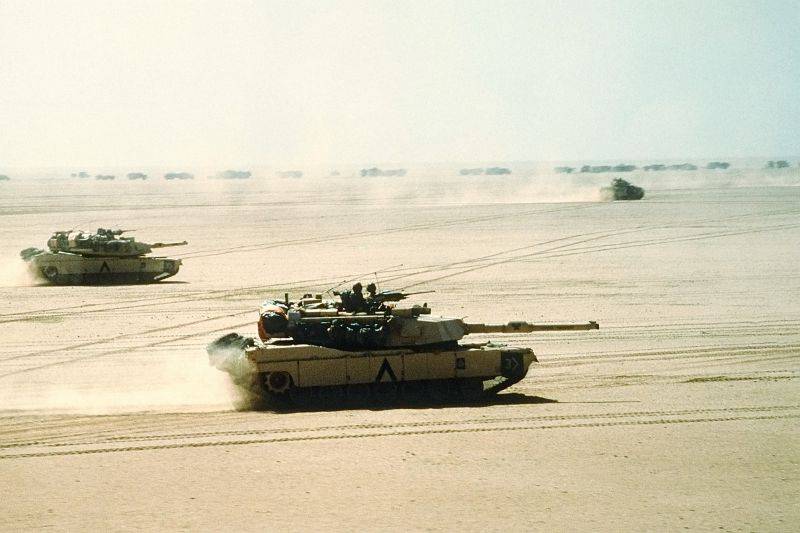

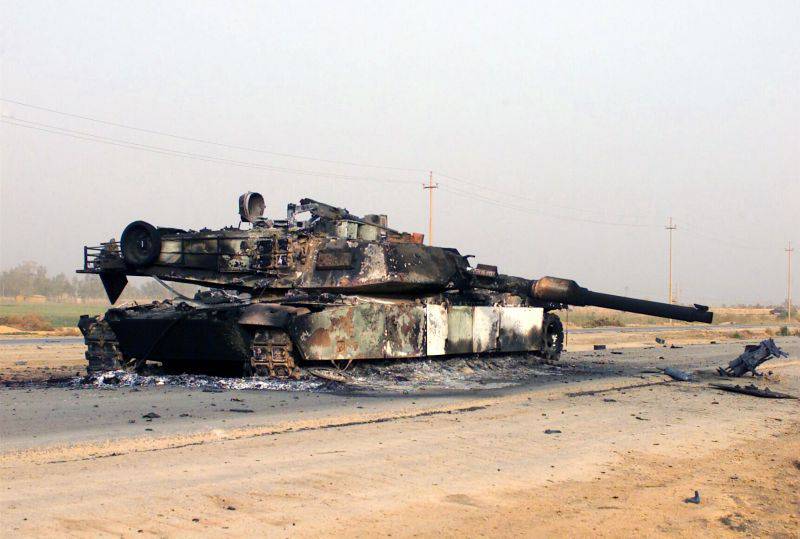
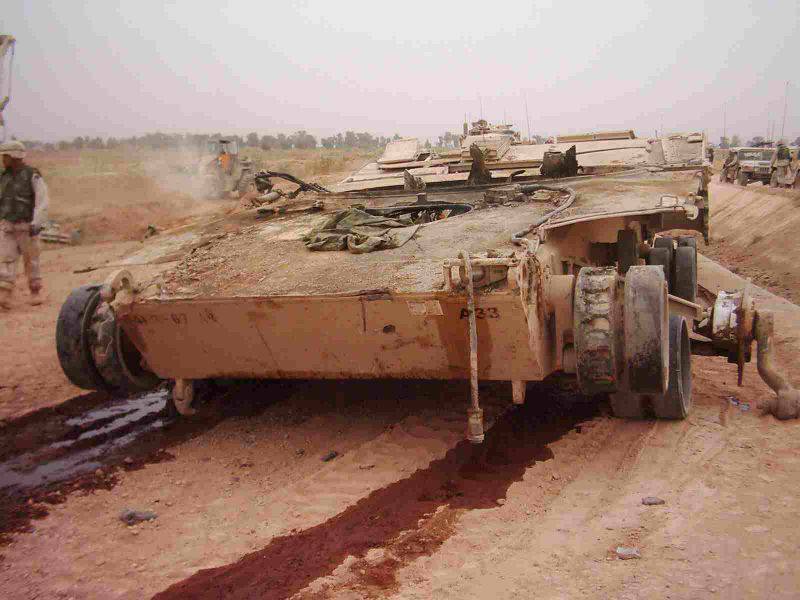
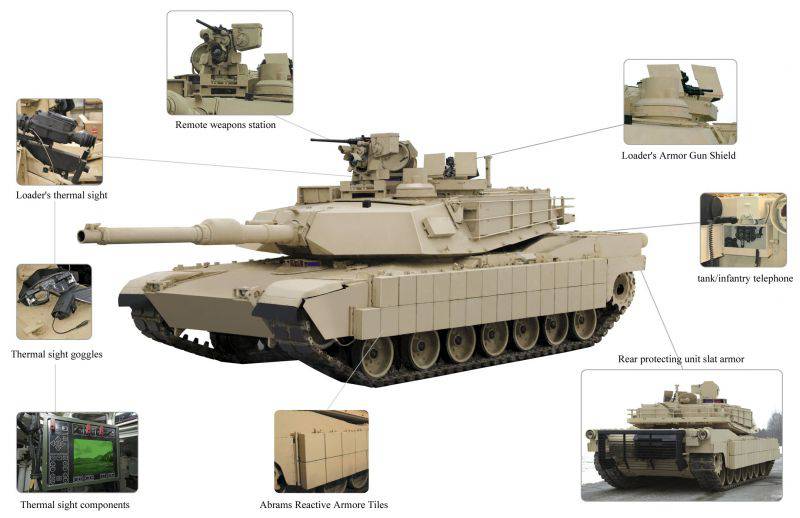
Information